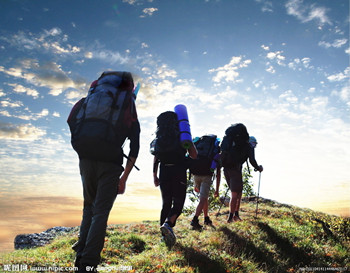(Ecns.cn)--Mountain climbing isn't only a classic sport, but also a challenging and exhilarating experience. In addition to the health reward, it brings the satisfaction of reaching the summit and dwarfing the city. However, this sport is not for everyone as it involves hardship, risk, and danger not suitable for certain groups.
To reach the next great summit or the top has always been the goal of mountaineering. This poses a significant challenge for those who are suffering from chronic conditions like hypertension and coronary heart disease. The higher one climbs, the less oxygen one receives during mountaineering. In the worst case scenario, it can trigger complications like cerebral hemorrhage, cardiac failure, and sometimes even myocardial infarction.
Diabetes patients should also stay away from the sport, no matter how interesting or irresistible they find it to be. Blood sugar normally rises while climbing, especially on the upper reaches of a mountain.
In addition, people with bad knees are not suggested to mountain climb. During the process of climbing upwards, blood circulation in the lower limbs slows or even shuts down, which may trigger pathologic fractures.
Even if your body is in perfect health, it's necessary to get familiar with some commonly seen hazards of the sport before driving the whole family into it on the weekend.
Before putting the whole mountaineering idea into practice, check the weather since it is always a great danger during mountain climbing. The combination of cold, snowy weather, which usually makes it difficult to see the area ahead of you, and the altitude, which makes it more difficult to breathe, make climbing to the summit of a tall mountain an extreme challenge. One must always bring proper gear during the climb and gauge the level of oxygen that has been brought along to remain safe.
The most obvious hazard lies in the danger of falling. Rough surfaces of exposed rock make it easy to break one's bones or even die instantly from comparatively short falls. Mountain climbers must continually be aware of the environment around them and make sure that their estimates of the strength and stability of the rock are correct. Before setting your body down, check out the rocks one is to apply weight to as rocks can be rotten and give way. The speed with which weight is transferred from one point to another is also important, as jerking motions are more likely to dislodge a hand or foot hold. Usually, experienced climbers take advantage of multiple support points to protect themselves in case one of their supports gives way. It is also clever, in cases where vertical or near vertical ascents are being undertaken, to climb in a team. When climbing together, team members must always be aware of each other's positions, as they rely on each other for physical support and for rescue if there is an emergency.
Keep in mind that mountain climbing is an unpredictable experience. Thus, it not only physically stimulates you, but mentally as well. The temperature on big mountains ranges from freezing to sweltering hot even in the same day as altitude, weather, and sub-angles change. These changes challenge your mental ability to plan in advance, improve, problem solve, and navigate, while physically challenging your body condition and climbing skills.
For all these reasons, it's wisest to build a healthy body before diving into mountain climbing.


















